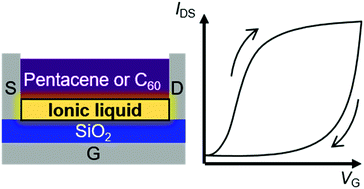Ionic liquid thin layer-induced memory effects in organic field-effect transistors†
Abstract
We examined the morphologies and structures of pentacene and C60 thin films grown on thin layers of an ionic liquid, N,N-diethyl-N-methyl-N-(2-methoxyethyl)ammonium bis(trifluoromethanesulfonyl)imide (DEME-TFSI), and found that the characteristics of the films depended significantly on the thickness of DEME-TFSI. In addition, we fabricated organic field-effect transistors (OFETs) of pentacene and C60 in which a thin layer of DEME-TFSI was inserted between the organic semiconductor (pentacene or C60) and the gate insulating layer, and measured their performance in situ. We found that 1.5–2 ML (ML: monolayer) DEME-TFSI produced a large hysteresis loop in the transfer characteristics in these OFETs, but 5 ML DEME-TFSI resulted in the formation of normally-on states with far smaller memory effects. The curvatures of the hysteresis loops were caused by the formation of trap states induced by the DEME-TFSI layers. This novel technique provides a simple tool for creating hysteresis behavior and could potentially be applied to transistor memory devices.



 Please wait while we load your content...
Please wait while we load your content...